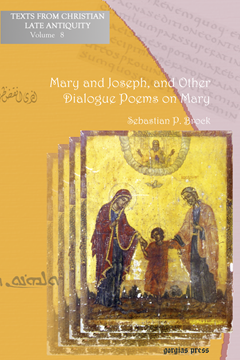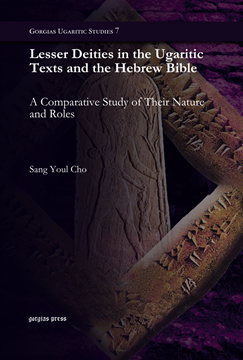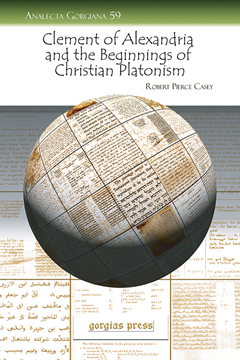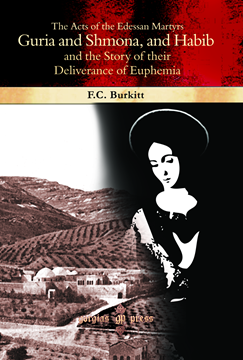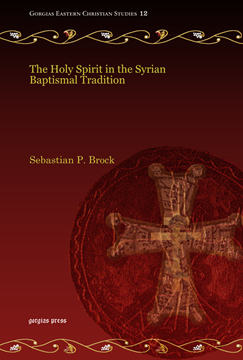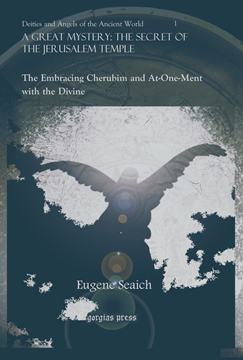American Journal of Ancient History (New Series 5, 2006 [2008])
Edited by T. Corey Brennan
Series: American Journal of Ancient History: New Series Volume 5
ISBN: 978-1-59333-837-4
A special book-length publication of T.R.S. Broughton, Autobiography. Edited by T. Corey Brennan (Rutgers University), with T. Alan Broughton (University of Vermont, emeritus), Ryan F. Fowler, Andrew G. Scott, and Kathleen J. Shea (Rutgers). Edition with introduction, notes, and annotated index of the unpublished autobiography of one of North America's foremost ancient historians, who lived 1900–1993. The volume contains also Broughton's unpublished 1970 lecture "Roman studies in the twentieth century", which masterfully places Lily Ross Taylor’s major works in their intellectual context.
$110.00 (USD) $66.00 (USD)
Mary and Joseph, and Other Dialogue Poems on Mary
Series: Texts from Christian Late Antiquity 8
ISBN: 978-1-59333-839-8
What was Joseph’s reaction when he arrived home to find Mary pregnant? How did Mary manage to persuade him that her child was none other than the Son of God? The Syriac literary tradition had a unique way of answering these sorts of questions raised by the Bible. Dialogue poems (sughyotho) offer lively, thought-provoking, and often delightful re-imaginings of Biblical events. They expand the Biblical stories, giving the familiar characters more dialogue and describing their inner thoughts. The collection provides five dialogue poems featuring Mary, in Syriac original with facing English translation.
$40.00 (USD) $24.00 (USD)
Christian Demonology
Series: Analecta Gorgiana 55
ISBN: 978-1-59333-870-1
This work is concerned primarily with the treatment of the demonic within early Christian literature, but also incorporates evidence from various other world religions, especially early Judaism and paganism.
$64.00 (USD) $38.40 (USD)
Lesser Deities in the Ugaritic Texts and the Hebrew Bible
A Comparative Study of Their Nature and Roles
Series: Gorgias Ugaritic Studies 7
ISBN: 978-1-59333-820-6
A comparative work on the nature and various roles of the lesser deities, the so-called angels, in the Ugaritic texts and the Hebrew Bible. Sang Youl Cho insists on the necessity for a comparative study between the two religious literatures from Ugarit and ancient Israel. The present study is interested in their membership in the heavenly council, their kinship among the deities, and their roles such as messengers, warriors, mediators, or servants, which have numerous similarities in the Ugaritic texts and the Old Testament.
$177.00 (USD) $106.20 (USD)
Assyrians in Yonkers
Reminiscences of a Community
ISBN: 978-1-59333-745-2
This book is Dr. Ameer’s reflection on growing up within the small community of Assyrian Christians in Yonkers, New York. He uses the year 1946 as an orientation for his discussion of that ethnic community, city, and time in history. The book enables readers to reflect on those aspects of community critical to civic support and on the process of successful assimilation in mid-twentieth century America. The author describes the experience of living in an ethnically, religiously, and racially diverse society. This will be of particular interest to people concerned with sustaining the idea of community in American life.
$96.00 (USD) $57.60 (USD)
The Testament of Solomon
Series: Analecta Gorgiana 56
ISBN: 978-1-59333-871-8
An excellent translation follows a critical essay, which argues that the Christian elements of the text do not point to a Christian author, but rather indicate that this work is a Christian recension of a Graeco-Jewish original.
$90.00 (USD) $54.00 (USD)
Clement of Alexandria and the Beginnings of Christian Platonism
Series: Analecta Gorgiana 59
ISBN: 978-1-59333-874-9
Casey’s survey reveals not only his adept insights into Clement’s thought but also the great breadth of his knowledge of the Greek philosophers and the early Jewish and Christian theologians in the Roman Empire.
$45.00 (USD) $27.00 (USD)
The Acts of the Edessan Martyrs Guria and Shmona, and Habib and the Story of their Deliverance of Eu
ISBN: 978-1-59333-872-5
In this book the Syriac texts along with translations of the tales of the martyrs themselves as well as the miraculous deliverance of Euphemia are introduced by Professor Burkitt with a commentary focusing on the historicity of the different accounts.
$151.00 (USD) $90.60 (USD)
The Holy Spirit in the Syrian Baptismal Tradition
Series: Gorgias Eastern Christian Studies 12
ISBN: 978-1-59333-844-2
A sensitive and evocative treatment of the role of the Holy Spirit in worship. With a keen awareness of the tradition of Syrian Christianity, Brock begins his exploration with the role of the Holy Spirit in the Syriac Bible. A striking aspect of this tradition is the imagery used for the Spirit, including: compassionate mother, fire, olive oil, as well as the more common image of dove. Brock also summarizes commentaries and other literature on the baptismal rite, touching on Syriac literature and works translated from the Greek.
$137.00 (USD) $82.20 (USD)
The Secret of the Jerusalem Temple
The Embracing Cherubim and At-One-Ment with the Divine
Series: Deities and Angels of the Ancient World 1
ISBN: 978-1-59333-840-4
In this thoroughly provocative book, the late Eugene Seaich makes a detailed study of the intractable mystery of the Jerusalem temple. Using historical sources and ingenious detective work, Seaich suggests that the cherubim in Solomon’s temple were portrayed in a copulatory embrace. Aware that this thesis is not entirely novel, the author builds a substantial case in its favor and traces the influence of the atonement (at-one-ment) theology behind the concept through Israel’s wisdom school, New Testament and Gnostic sources, up through the Middle Ages.
$207.00 (USD) $124.20 (USD)
![Show details for American Journal of Ancient History (New Series 5, 2006 [2008]) Picture of American Journal of Ancient History (New Series 5, 2006 [2008])](https://gorgiaspress.com/images/thumbs/0011843_american-journal-of-ancient-history-new-series-5-2006-2008_360.png)
